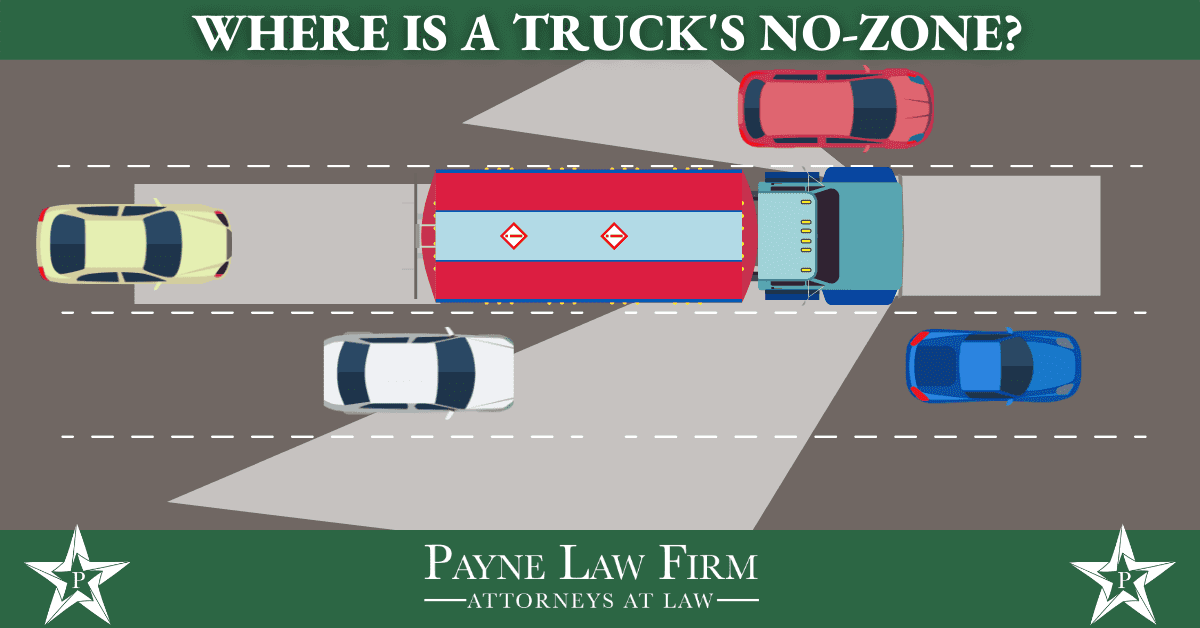Poor passing and merging technique is one of the top causes of truck accidents in the U.S. According to NHTSA’s latest data, there were 497 fewer fatalities in crashes involving large trucks in 2023, representing an 8.3% decrease from 2022, with 5,472 people dying in accidents involving large trucks (13.4% of all traffic-related deaths). Federal traffic-safety analysts estimate that roughly 300 people are killed each year in crashes directly attributable to truck blind spots. These crashes can happen at any time and it’s often because drivers don’t understand how a truck’s shape limits visibility.
To help you stay safe on the roads and tell when a truck driver can see you, we need to answer a very important question: What is a truck’s no-zone?
The No-Zone Explained
The no-zone is a special term used to describe a semi-truck’s blind spots. Because trucks are larger and longer than other vehicles, they have restricted visibility compared to other vehicles. To be clear: the no-zone isn’t an area of low visibility; it’s an area of zero visibility.
To better understanding how the no-zone works, we’ve made a graphic to explain. The semi-truck’s blind spots are marked in white.

Front and Back
From this, we can determine a few things. First, semi-trucks drivers cannot see anything either 20ft in front of their vehicle or 30ft behind their trailer.
If a car is following too closely, the truck driver may not realize someone is behind them. That could be extremely dangerous if someone either moved from one no-zone to another (like if a driver attempted to pass on the right) or if both vehicles changed lanes at the same time.
The same applies to drivers who are too close to the front of the truck. If someone were to merge too close to the cab and then hit the brakes, the truck driver might not see their brake lights or even realize that someone is in their no-zone. This is where many preventable semi-truck accidents occur.
Left and Right
The sides of the truck are also danger zones and can present challenges to drivers who aren’t aware of these limitations. There is a small no-zone on the driver’s side between the trailer and the cab. The danger here is that a driver lingers in the no-zone and a truck driver loses track of them.
The passenger’s side is especially worrisome as it is much larger and extends across multiple lanes. This is why you should never pass any vehicle on the right side. If the truck needs to merge into the right lane or get to an exit, the driver may not realize you are in their no-zone.
Safe Passing
Given the scope of a semi-truck’s no-zone, it’s essential to understand the proper passing and merging techniques that can help you avoid a serious accident. Some of our most impactful tips for safely passing a truck include:
Commitment
The longer you’re in a truck’s no-zone, the more likely the truck driver is to lose track of you. An effective way to stay safe is to commit to passing the truck quickly once you enter the passing lane and avoid lingering next to their trailer.
Full Visibility
When it’s time to merge back into the travel lane, remember to provide enough space so the truck driver can see you. As a general guide, if you can see the entire truck in your rear-view mirror, the truck driver can see you.
See What They See
Finally, remember that mirrors work both ways. If you can see the truck driver’s face in their side-view mirror, you know that you are not in their no-zone. Additionally, know that more and more semi-trucks are being equipped with blind-spot mirrors specifically designed to counteract the no-zone.
The better you are at identifying when you’re in the no-zone, the better your chances of avoiding an accident. Next time you come upon a large truck, try to tell when the driver can see you, and remember to provide a little extra space before passing and merging.
If you were hit and hurt in a truck accident, we’re here to help. To schedule a free case consultation with an experienced truck accident lawyer from Payne Law Firm, please don’t hesitate to call (713) 999-4801 or send us an email.

